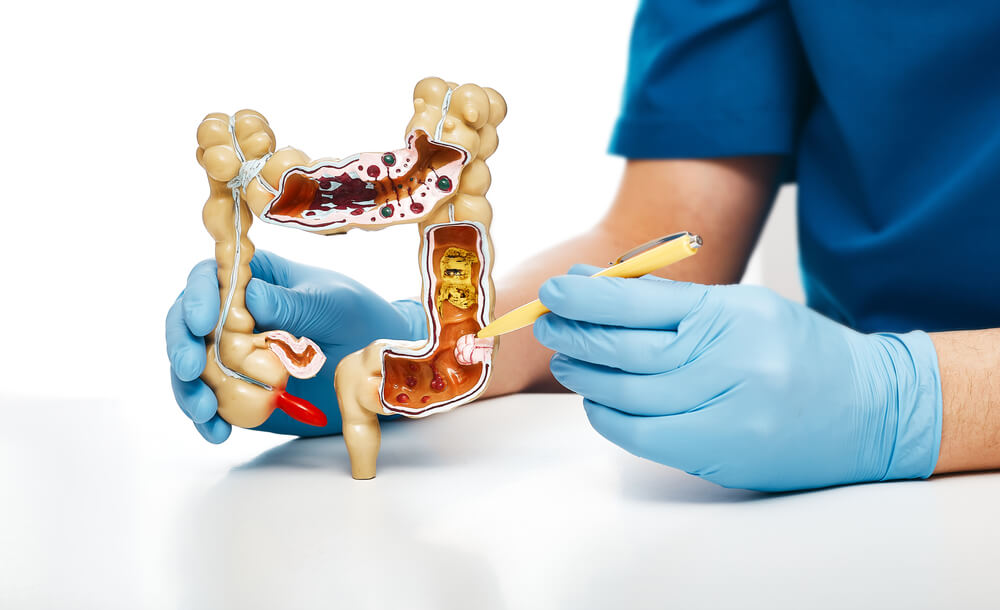As the name suggests, colorectal cancer types develop either in the rectum or the colon. If the mass starts in the colon, it’s usually identified as colon cancer. Naturally, if the mass develops in the rectal area, experts will refer to it as rectal cancer. These different cancer types actually have a lot in common; that’s why professionals will refer to them as colorectal cancer.
In this blog post, we will talk briefly about the different types of colon cancer, talk about the symptoms of rectal cancer, and potentially discuss colon cancer surgery options as well.
Most Common Colorectal Cancer Type
Adenocarcinoma is the most prevalent colorectal malignancy, making up around 95% of all colon and rectal cancer cases. These masses develop in the cells inside the large intestine’s lining and usually start to develop as polyps. Fortunately, experts will usually remove them during a colonoscopy to avoid them turning cancerous.
More specifically, these malignancies grow in the epithelial cells, developing in the large intestine’s lining (in the colon) or at the colon’s end (the rectum).
Furthermore, adenocarcinoma has two subtypes, which are:
- Signet ring cell adenocarcinoma is responsible for less than 1% of all colorectal cancers. This is a rather aggressive rectal cancer type that’s usually more challenging to treat.
- Mucinous adenocarcinoma usually consists of around 60% mucus, causing the cancerous cells to spread faster and become more aggressive than “traditional” adenocarcinomas.
Most generalized information about colorectal cancer usually refers to “traditional” adenocarcinoma. Estimates say that around 4.1% of people may develop these cancer types during their lifetime.
Rectal cancer symptoms in the case of adenocarcinoma include:
- Tenderness and pain in the abdomen
- Bloody stool
- Constipation or diarrhea
- Unexplained weight loss
- Thinner stools
As with other types of colon cancer, adenocarcinoma can’t be prevented but may be caught before turning more severe. Because of this, experts recommend colon cancer screening for individuals over 45.
Diagnosis will start with asking the patient about their symptoms. A colonoscopy and a biopsy may also be performed, along with blood tests, CT and MRI scans to help the professionals establish a proper diagnosis and learn more about the cancer.
As far as treatment goes, depending on the cancer’s stage and other circumstances, healthcare providers may recommend:
- Surgery
- Radiator therapy
- Targeted therapy
- Chemotherapy

Less Common Types of Colon and Rectal Cancer
Apart from adenocarcinoma, other malignancies are much rarer but may still develop in some cases. These masses in the colon/rectum include:
- Carcinoid tumors
- Melanomas
- Primary colorectal lymphomas
- Leiomyosarcoma
- Gastrointestinal stromal tumors
Carcinoid Tumors
These cancers of the rectum develop in the neuroendocrine cells (nerve cells) that aid in hormone production. These malignancies are classified under the group of tumors called NETs or neuroendocrine tumors. These masses usually grow slowly and will usually develop somewhere in the gastrointestinal tract or the lungs.
Depending on where they form, they can produce different symptoms. For instance, they may only cause symptoms in the appendix unless they block its pathway to the intestine. If it’s rectal cancer by position, the tumor may cause constipation, rectal pain, and constipation.
They can also cause hormonal disbalances that may produce symptoms like rapid heartbeat, wheezing, diarrhea, and flushing of the face.
Because they can develop in different areas, they can be discovered during routine checkups or, for instance, when the patient is being checked for appendicitis.
Treatment options will usually include surgery, chemotherapy, hormone therapy, and chemotherapy.
Rectal and Colon Leimyosarcomas
These masses in the colon usually develop in the muscle types that help the waste through the entire digestive tract. They are extremely rare, accounting for only 0.1% of all cancers of the rectum/colon.
They may produce symptoms only in later stages, like weight loss, blood vomiting, stool changes, fatigue, and so on.
They are usually diagnosed through blood and imaging tests and biopsies, with treatment generally starting with surgery and followed by other methods such as chemo and radiation therapy.
GISTs or Gastrointestinal Stromal Tumors
These are also rare cancers of the rectum/colon that develop in the gastrointestinal tract’s lining, with most of them growing in the stomach. Still, they may also appear in the small intestine or the rectum.
These are usually slow-growing malignancies that will start showing symptoms later.
The symptoms of this type of rectal cancer may include:
- Nausea
- Vomiting
- Abdominal masses
- Pain in the abdomen
- Problems swallowing
- Weigh loss
After establishing a diagnosis, smaller tumors may not be treated immediately, while others will usually be removed with surgery and further treated with targeted therapy.
Primary Colorectal Lymphoma
This is a non-Hodgkin lymphoma type that grows in the lymphatic system, in white blood cells that help the body with fighting off infections. These malignancies will usually develop in older patients, and it’s usually more common in men.
Rectal and Colon Melanomas
While melanomas are primarily associated with skin cancer, these malignancies can grow anywhere. Melanoma cancers of the rectum and colon are usually rare (accounting for 1 to 3% of all colorectal cases) and may be treated with radiation therapy, surgery, immunotherapy, and/or chemotherapy.
Colorectal Squamous Cell Carcinoma
Another extremely rare cancer of the rectum/colon that’s also mostly associated with skin cancer.
For the most part, symptoms may be similar to adenocarcinomas. Before starting the treatment, it’s imperative to determent whether the cancer began in the colon or rectum and where it has spread. Treatment won’t be standardized, but it will most likely include surgery, radiation therapy, and chemo.
FAP or Familial Adenomatous Polyposis
People who have this syndrome can develop several hundred rectal or colon polyps, and unfortunately, all patients who suffer from this disorder will develop colorectal cancer at some point. To prevent the malignancy, some people will have their colon removed.

Genetic Risks
Some people may inherit a syndrome that’s associated with colorectal cancer. In these cases, they may undergo genetic testing and may be recommended regular checkups and screenings to catch the malignancies early if they appear.
Such familial cases include Lynch syndrome and familial adenomatous polyposis. People who are dealing with Lynch syndrome are at a higher risk of developing these malignancies (around 50%). Also, patients with Lynch syndrome tend to develop these malignancies at an earlier age than in most cases.
The Importance of Screening and Early Detection
No matter which cancer we’re talking about, timely detection and regular screenings are imperative for making a full recovery and avoiding any severe complications. Learning about your family history and limiting the associated risks with colorectal cancer may help most people avoid the disease. Getting regular exercise, eating more fruits and vegetables, maintaining a healthy weight, avoiding alcohol and tobacco, and limiting the intake of processed foods, are all stellar ways to reduce the risks associated with these malignancies.
For more information regarding these malignancies, feel free to reach out to Dr. Omar Rashid, Medicus Elite, who will answer your questions and concerns.


